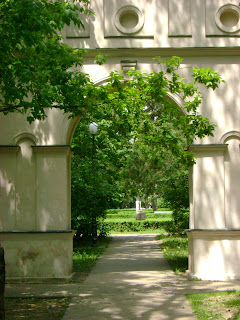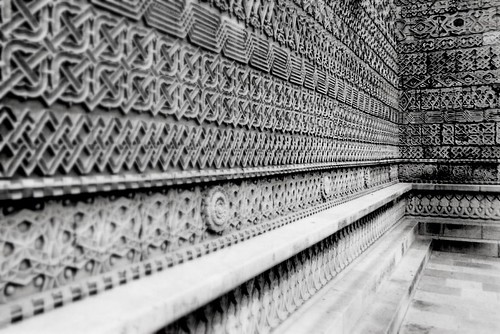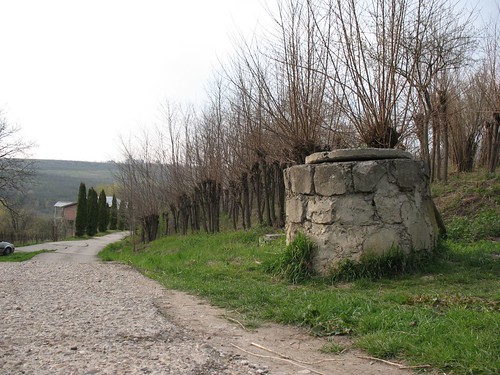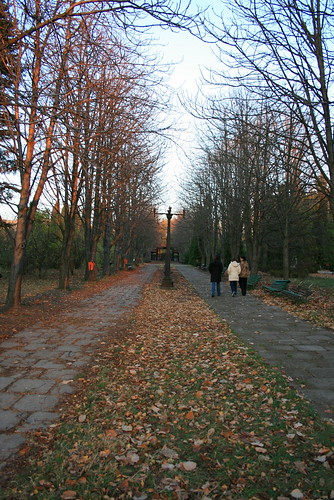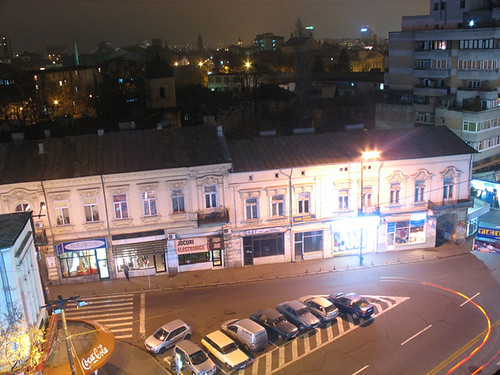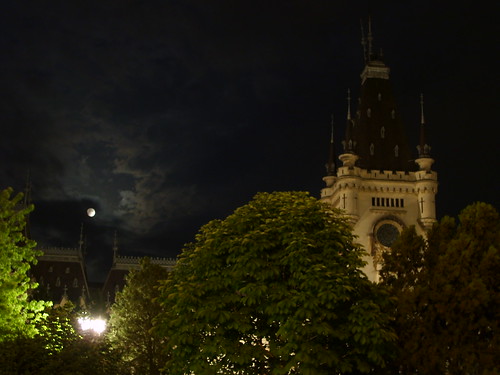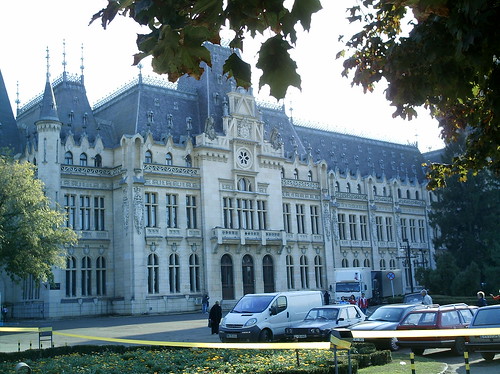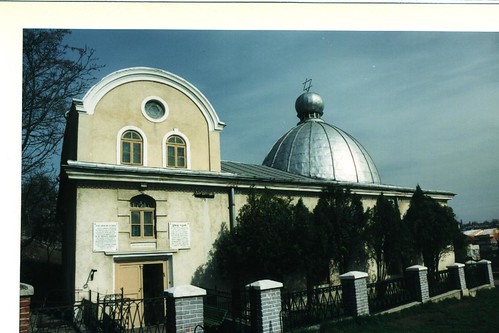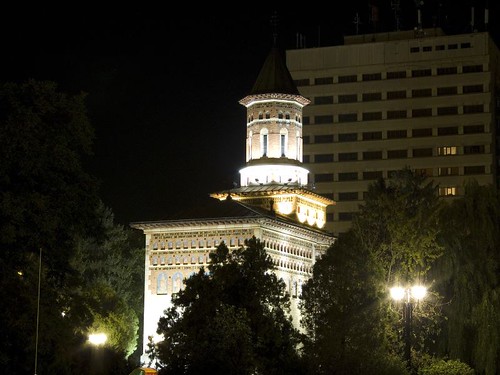I am so glad that today is the last day of campaign in Iasi, at least for first round.
I just had enough of the posters all around the city, a lot of promises, and a lot of blame these days.
The actual mayor did everything he could to have the city's sympathy to get another mandate for the city hall, but we all noticed the difference and i think we didn't fall for that.
I dunno who i am gonna vote with...
Nichita ...no...
Adomnitei... don't think so
Oprea...I don't now
these are the first three candidates that have the best chances to win.
so i guess we will find out sunday!
Friday, May 30, 2008
elections in iasi! over
Thursday, May 22, 2008
Iasi | Old Vs New
Iasi Old Vs New photo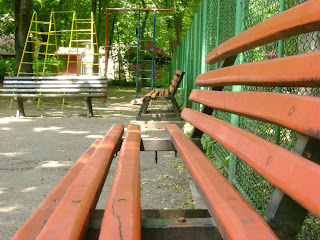
Iasi Old Vs New photo
Sometimes I wonder when did the time go by so fast. It seems like yesterday I was playing with my friends in the park. I was skipping classes just to ride in one of these old fashion gliders, and now... they seem tired.
Now, there's no one, new shiny playgrounds are near...
A little bit nostalgic? yes I am...
(The pictures were taken in Expo Park | Iasi)
Tuesday, May 20, 2008
Monday, May 19, 2008
To visit | IASI
To visit | IASI
ok. so you want to come in Iasi and visit something. But what?
Well this is what i advise you.
1. Metropolitan Cathedral & "Trei Ierarhi" church.
2. Bucium plateau
3. Palace of Culture
Tuesday, May 13, 2008
Old pictures of Iasi
Old pictures of Iasi
Lapusneanu street - old picture
Strada lapusneanu
Rapa galbena
Universitatea Al.I. Cuza
Mitropolie iasi
Vedere generala a Iasului
Old pictures of Iasi
National Theater Iasi V. Alecsandri
National Theater Iasi V. Alecsandri pictures
Old pictures of iasi
Fotografii vechi iasi - Teatrul national V. Alecsandri
Old tram In iasi
This is old tram that we see at every major event or celebration in iasi. It's pretty cool, although is very small.
Sunday, May 11, 2008
Living in Iasi Translated
Thanks to google now you can translate everything that is written on this web page in you mother tongue with only one click.
In right first thing on the page, it's new gadget that allows you to translate easily the entire blog.
It's not gonna be the perfect translation but hey... it is something.
Theatre Festival In Iasi 9-15 may 2008
Theater Festival In Iasi 9-15 may 2008 Festival Theatre
Festival Theatre
Locatie: Ateneul Tatarasi, Teatrul Luceafarul, Casa de Cultura a Studentilor Location: Athenaeum Tatarasi, Luceafarul Theatre, Cultural Students
Data: 19 - 25.05.2008 Date: 19 - 25.05.2008
Pret: - Price: --
Web: www.euroartiasi.ro Web: www.euroartiasi.ro
Email: - Email: --
Description:
"Through the festival theatre Iasi make Euro-Art want to bring in the halls of theater people who" forgot "to do so in May. I wish very much that the pilot edition this year will be an even more successful. It's a dream beautiful that should be permanentizeze and Iasi make Euro-Art could become a powerful brand of the city.
The event should be taken as an edition began a long story, a success story. It is important that the festival begins now and has not been postponed to a date.
The festival is addressed to all lovers of art, but not hide the fact that trying to bring in the halls shows how many young people. " In this sense, they propose some wonderful performances, the actors playing very young. "
Adi Afteni, festival director
Program:
Luni, 19 mai Monday, May 19
Atheneum Tatarasi at 18:00
Universitatea “Babes-Bolyai” Cluj "Babes-Bolyai" Cluj
“Amor venetian” "Amor venetian"
ora 20:00 Theatre "Luceafarul" at 20:00
Production UNITER
Ion Caramitru and Jonny Raducanu
"Dialogues and Fantasy in jazz"
Casa de Cultura a Studentilor at 22:00
, Bucuresti National Theatre "IL Caragiale", Bucharest
“Sanziana si Pepelea”
Marti, 20 mai Tuesday, May 20
Atheneum Tatarasi at 18:00
Facultatea de Teatru, Chisinau Department of Theatre, Kishinev
“Ploaia”
Theatre "Luceafarul" at 20:00
, Bucuresti The Theatre "D'AYA, Bucharest
“Dragostea dureaza 3 ani” "Love lasts 3 years"
Casa de Cultura a Studentilor, at 22:00
Comedy Theatre Bucharest
“Dumnezeul de a doua zi" "God of the second day"
Wednesday, May 21
Atheneum Tatarasi at 18:00
University of Arts "George Enescu" Iasi, the Department of Theatre
"Request in marriage"
Theatre "Luceafarul" at 20:00
Theatre "Nottara", Bucharest
“Variatiuni enigmatice” "Variations enigmatice"
Casa de Cultura a Studentilor at 22:00
Theatre "Metropolis" Bucharest
"No One"
Joi, 22 mai Thursday, May 22
Atheneum Tatarasi at 18:00
National University of Theater and Film Arts, Bucharest
“A douasprezecea noapte” "A night douasprezecea"
Theatre "Luceafarul" at 20:00
Teatrul de Stat, Oradea State Theatre, Oradea
“Comedie pe intuneric” "Comedy in the darkness"
Casa de Cultura a Studentilor at 22:00
Teatrul National “Marin Sorescu”, Craiova National Theatre "Marin Sorescu," Craiova
“Canta maica-mea in far” "Play-maica far in my"
Vineri, 23 mai Friday, May 23
Atheneum Tatarasi at 18:00
Universitatea Craiova, Facultatea de Litere, Dep. Universitatea Craiova, Faculty of Letters, Dep de Arta Teatrala Art Theater
“Povesti de familie” "Canadian family"
Theatre "Luceafarul" at 20:00
Teatrul “Mihai Eminescu”, Botosani Theatre "Mihai Eminescu," Butterworth
“Visul unei nopti de vara” "Dream of Summer Nights"
Casa de Cultura a Studentilor at 22:00
Teatrul National “Vasile Alecsandri”, Iasi National Theatre "Vasile Alecsandri", Iasi
“Nevasta lui Hans sau Ce sa caute un inger in orasul asta” "Nevasta What's Hans or to seek an angel in this town"
Sambata, 24 mai Saturday, May 24
Atheneum Tatarasi at 18:00
Universitatea de Arte “George Enescu” Iasi, Departamentul Teatru University of Arts "George Enescu" Iasi, the Department of Theatre
“Mistretul cu colti de argint” "Mistretul with silver colti"
Theatre "Luceafarul" at 20:00
Teatrul “ApARTe”, Moscova Theatre "ApARTe", Moscow
“Sotia din Sahalin” "Wife of Sahalin"
Casa de Cultura a Studentilor at 22:00
Teatrul “Act”, Bucuresti Theatre "Act", Bucharest
“Capra sau Cine e Sylvia?” "Goat or Who is Sylvia?"
Duminica, 25 mai Sunday, May 25
Atheneum Tatarasi at 18:00
Universitatea de Arta Teatrala, Tg. University of Dramatic Art, Tg. Mures
“Fantomele Madridului” "Fantomele Madrid"
Theatre "Luceafarul" at 20:00
Teatrul “ApARTe”, Moscova Theatre "ApARTe", Moscow
“Dupa caderea cortinei” "After the curtain falls"
Casa de Cultura a Studentilorat 22:00
Teatrul “Act”, Bucuresti Theatre "Act", Bucharest
“Capra sau Cine e Sylvia?” "Goat or Who is Sylvia?"
Saturday, May 10, 2008
Iasi virtual tour
A pretty cool site about iasi is www.360city.ro. Here you can find a series of virtual tours with the main attractions in IASI.
You can find 360 images with: Palace of culture, City Hall Of Iasi(Palace Roznovanu), University of medicine and farmacy Iasi, University Al. I. Cuza Iasi, Central Library M. Eminescu, Copou Garden(Copou Park ) and the Botanical Garden Iasi.
There are hi quality pictures that show you the place and the surroundings.
the virtual tours of Iasi is HERE.
Friday, May 9, 2008
Goran Bregovici concert in Iasi
Goran Bregovici concert in Iasi.
yeah, yeah really nice everybody is so happy and we are celebrating the Europe Day.
Sincerely i really hate this kind of manifestation in IASI. All the creepy people get out from their neighborhood and go to see the concert, not because they know who is Goran bregovici, but because they need to get out from their crowded flat, where they listen shitty music all the time and drinking cheap beer.
most of the time you can see them leaving in groups of ten or more, already drunk and swearing and bullying everybody.
And all this is true.
So be careful , if you are a tourist in iasi you would better avoid this kind of manifestation.
I'm not saying that all the people that go to the concert are like this, but the majority is.
Iashington
Iashington represents an international conference, organized by AIESEC IASI (Romania),which purpose is to bring 160 participants from different countries, merging them around the idea of multiculturalism and professional growth and development.
For an unique learning experience, this conference intends to combine themes of present interest with distinguished speakers, keen elements and a friendly format and last but not least relaxation and entertainment with educative activity.
For those 100 international delegates and 30 up to 60 local and national representatives there will be made available 6 different tracks which to attend: Leadership, Project Management, Entrepreneurship , Development Durable, Training and Human Resources.The sessions for this tracks will take place in groups established for the entire duration of the conference and each group will debate a certain topic starting from morning until 14-15 o'clock in the afternoon. After a lunch break those who are present, will have the chance to take part in a series of debates, panel discussions, presentations, discussion on a chosen topic by a speaker from a certain field of work.
A variety of recreational and social activities, such as parties, hanging out, having a traditional dinner, Global Village, "treasure hunt", team-building are planned in the evening. At the end of the conference, an official Gala will take place, during which the partners will be presented, the topics of discussion addressed during the Iashington 2008 event, learning points, initiatives. Ultimately of Iashington there is the possibility to opt for a Study Tour.
A practical application will be created, common to every participant : discovery of the most original and interesting aspects of Iasi, evaluating and studying Iasi from the cultural and touristic point of view, finding out solutions to ameliorate the identified situations.
To attend this conference, that will take place between 1-7 September 2008, the delegates have to fill in an application form. Subsequently the must pay a 100-euro fee. This fee will provide the applicants accommodationat the "Alexandru Ioan Cuza" University Student Campus and 3 meals a day.
Distances to iasi from main cities
Distance to Iasi from:
| City | Distance (Miles) |
| Bucharest | 269 |
| Arad | 387 |
| Belgrade | 495 |
| Brasov | 180 |
| Budapest | 495 |
| Cluj-Napoca | 234 |
| Constanta | 260 |
| Oradea | 322 |
| Prague | 813 |
| Satu Mare | 277 |
| Sibiu | 264 |
| Sighetu Marmatiei | 170 |
| Sighisoara | 180 |
| Suceava | 85 |
| Timisoara | 415 |
| Vienna | 642 |
Museums In Iasi
Museum of Moldova (Complexul Muzeal National Moldova)
Address: Piata Stefan cel Mare si Sfant 1
(housed in the Palace of Culture / Palatul Culturii)
Tel: (232) 218.383
Email: contact@muzeul-moldova.ro
Web: www.muzeul-moldova.ro
Open: Tue. – Sun. 10:00am – 5:00pm; closed on Mon.
Admission charge (tickets may be purchased for one or all four museums)
1. Moldavian Ethnographic Museum (Muzeul Etnografic al Moldovei)
The Moldavian Ethnographic Museum is one of the oldest and largest in the country. Encompassing 16 rooms, the displays cover every aspect of traditional Moldavian life, featuring agricultural and hunting tools, woodwork, traditional pottery, painted eggs and a good collection of textiles and dyed carpets embroidered with bird and plant motifs. One room exhibits winter customs items, including masks representing the bear, the goat and other characters of traditional New Year’s festivities. The collection of wooden machinery is impressive with 19th century tree-size oil and wine presses.
2. Art Museum (Muzeul de Arta)
The art collection began with a set of oil paintings purchased at a Parisian auction in 1845. The official opening took place in 1860 at the Old University Palace and in 1955, the museum moved to its current location in the Palace of Culture. An excellent collection of Romanian paintings from the 19th and 20th centuries vividly illustrates Moldavian rural life and its landscape. Nicolae Grigorescu’s Car cu Boi (Ox Cart), Theodor Amann’s Hora de peste Olt (The Village Dance) and O. Bancila’s Batran Croitor (Old Jewish Tailor) are some of the collection’s highlights.
In the four rooms devoted to European art, there are paintings by Murillo, Philippe de Champaigne, Paolo Veronese and a Rubens, Cezar Receiving Pompey’s Head. Additionally, you’ll find works by foreign artists who lived and worked in Iasi such as Schiavonim Livaditii and Stavscki.
The sculpture collection includes pieces by national artists such as Oscar Han, Cornel Medrea, Ion Jalea and Ion Irimescu.
3. Moldavian History Museum (Muzeul de Istorie al Moldovei)
Opened in 1955, this museum features some 35,000 objects spanning the centuries from 70,000 B.C. until 1946. These exhibits cover 19 rooms on the ground floor of the Palace of Culture. Some of the famous Cucuteni ceramics are on display here.
The museum also houses the vaulted King’s Room (Sala Voievozilor), a gallery of medallion-shaped portraits depicting Moldavian sovereigns from 81 A.D. to the Hohenzollern kings.
4. Science and Technology Museum (Muzeul Stiintei si Tehnicii)
Radio, television, recording and broadcasting buffs will enjoy the exhibits displayed in this museum. The last section features a superb collection of musical instruments: unique Romanian music boxes, mechanical accordions and an automated orchestra with three violins and a piano.
Natural History Museum (Muzeul de Stiinte al Naturii)
Address: Blvd. Independentei 16
Tel: (232) 218.337
Open: Tue. - Sat. 9:00am – 4:00pm; Sun. 10:00am – 5:00pm; closed on Mon.
Admission charge
The Moldavian Society of Physicians and Naturalists opened their collection to the public in 1834. Today, the museum features 50,000 exhibits, illustrating fauna from around the world, and is one of the largest of its kind in Europe. A special section is dedicated to Moldavian geology. Apart from its minerals, the museum also has a collection of prehistoric fossils containing fragments of mammoth, cave bear and rhinoceros.
Interesting facts:
The museum is housed in the 18th century Russet House, where Alexandru Ioan Cuza was elected Prince of Moldavia in 1859.
Theatre Museum (Muzeul Teatrului)
Address: Str. Vasile Alecsandri 5
Tel: (232) 115.760
Open: Tue. – Sun 10:00am – 5:00pm; closed on Mon.
Admission charge
The museum is housed in a late 18th century house, once the property of poet and diplomat Vasile Alecsandri (1821-1890), who played an important role in the founding of Moldavian theatre. The museum celebrates the history of theatre in Iasi and displays costumes worn by well-known actors in memorable roles, original documents, playbills and posters, as well as personal artifacts and memorabilia donated by various actors.
Jewish Iasi
In the 19th century, Iasi was one of the great Eastern European centres of Jewish learning, famous for its scholarly rabbis, intellectuals and skilled craftsmen, as well as for its Jewish schools, hospitals, publications and other organizations.
In 1855, the city was the home of the first-ever Yiddish-language newspaper, Korot Haitim, and was the birthplace of the Israeli national anthem. The world’s first professional Yiddish-language theatre was opened here in 1876 by Avram Goldfaden, who later founded New York’s first Jewish theatre. From 1949 to 1964, Iasi was also home to a second company of the State Jewish Theatre.
Jewish merchants from Poland settled here in the 15th century and their numbers swelled with further waves of Russian-Jewish and Galician-Jewish immigration into Moldavia. By 1930, there were over 30,000 Jews and some 127 synagogues. Today, only two synagogues remain open.
During the early years of World War II, Iasi was the scene of a pogrom by the Iron Guard, a nationalist Fascist organization. The majority of the city’s Jewish population was killed or deported. A monument to the victims of the 1941 pogrom was erected outside the Great Synagogue.
The Great Synagogue (Sinagoga Mare)
Address: Str. Sinagogilor 7
The Great Synagogue of Iasi is the oldest surviving Jewish prayer house in Romania and the second oldest synagogue in Europe. It was founded in 1670, reportedly at the initiative of Rabbi Nathan (Nata) ben Moses Hannover, religious leader of Iasi’s Jewish community in the 1660s and author of Yeven. Mezullah. Located on Synagogues Street (so dubbed because of the many synagogues once found here) in the old Jewish neighborhood of Targu Cucului, the synagogue was built in an eclectic style with strong late baroque influences. Since its foundation in the second half of the 17th century, the Great Synagogue has undergone a number of major renovations.
Although called “the great," the size of the synagogue is actually very modest. The floor is located below street level in keeping with a widespread tradition found in many Central and Eastern European synagogues. Jewish religious tradition requires that synagogues should be the highest buildings in their neighborhoods but because Jews were not permitted to build high structures for their prayer houses, lowering the floor of synagogues represented an ingenious compromise between the two demands by creating an interior that is higher than the exterior elevation of the building. It also serves as a reminder of Psalm 130 ("de profundis"): "Out of the depths have I cried unto Thee, o Lord".
Today, the Great Synagogue continues to serve the Jewish community of Iasi. It has been recognized as a historical monument.
The Iasi Jewish Cemetery
Address: Sos. Pacurari (bus and trolleybus connections from Piata Eminescu)
Open daily
Admission charge
Many of the victims of the 1941 pogroms were buried in the Jewish Cemetery, located outside the city on Dealul Munteni (Mountain Hill). Over 100,000 graves, some dating from the late 1800s, stretch across the hillside; burial records date from 1915 to the present day and are kept in the community centre. The second, smaller synagogue is also located here.
Jewish Community of Iasi (Comunitatea Evreiasca din Iasi)
Address: Str. Elena Doamna 15
Tel: (232) 313.711
British Council Centre Iasi
British Council Centre Iasi
Str.Pacurari 4
700511 Iasi
T/F: 0232 316159
E-mail: bc.iasi@britishcouncil.ro
Opening Hours
For the Centre
Mondays through Fridays: 09:00 - 17:00
For the Library
Monday, Tuesday and Thursday: 13:00 - 19:00
Wednesday and Friday: 10:00 - 16:00
Iasi – cultural breeding ground
The beginnings of higher education in Iasi date from the reign of Vasile Lupu (1634-1653). In 1640, Lupu founded an academy at the Three Hierarchs Monastery.
In the 18th century, a Royal Academy was established in one of the buildings attached to the Metropolitan Cathedral. The institution was closed down by the Ottomans after the Greek Revolution of 1821, but Gheorghe Asachi reopened it under the name of The Vasilian Gymnasium seven years later. In 1835, it was renamed The Mihailean Academy and had three sections: Philosophy, Law and Theology, as well as two special courses, Polytechnic Sciences and Economy.
In 1860, Alexander Ioan Cuza founded the University of Iasi. Today, this university is comprised of 26 colleges and eight research institutes of the Romanian Academy.
Old University Palace (Vechea Universitate)
Address: Blvd. Independentei 35
Commissioned by Ioan Cantacuzino between 1760 and 1765, the Old University Palace was badly damaged during a fire in 1795. Later renovated and converted into a royal residence, it remained in royal use until 1806. The stone arch in front of the palace dates from this period. On it, you can see the Moldavian coat of arms and a Cyrillic inscription spelling out the words the door of hope. In 1860, the building became home to the newly established University of Iasi and to the first public art collection in the country. Today, it houses the Medicine and Pharmacy College.
University on Copou Hill (Universitatea Alexandru Ioan Cuza)
Address: Blvd. Carol I nr. 11
The main university building was built between 1893 and 1897 on the site of the Great Theatre which had burned down. The Hall of the University, known as The Hall of the Lost Footsteps, served as a parliamentary debating chamber between 1917 and 1918. In 1967, the painter Sabin Balasa created a series of strongly romanticized frescoes for the arcades.
Central University Library (Biblioteca Centrala Universitara Mihai Eminescu)
Address: Str. Pacurari 4
Located at the base of Copou Hill, this triangular building with Doric columns and cupola was built between 1930 and 1935 to serve as the headquarters of King Ferdinand’s Cultural Foundation. The building was decorated with Carrara marble and Venetian mosaics. By 1945, the Foundation library had become one of the biggest in the country with more than 300,000 volumes. Today, the library is the largest in Moldavia, with a great number of manuscripts and old books from the 15th to the 19th centuries.
Iasi – cultural breeding ground
The beginnings of higher education in Iasi date from the reign of Vasile Lupu (1634-1653). In 1640, Lupu founded an academy at the Three Hierarchs Monastery.
In the 18th century, a Royal Academy was established in one of the buildings attached to the Metropolitan Cathedral. The institution was closed down by the Ottomans after the Greek Revolution of 1821, but Gheorghe Asachi reopened it under the name of The Vasilian Gymnasium seven years later. In 1835, it was renamed The Mihailean Academy and had three sections: Philosophy, Law and Theology, as well as two special courses, Polytechnic Sciences and Economy.
In 1860, Alexander Ioan Cuza founded the University of Iasi. Today, this university is comprised of 26 colleges and eight research institutes of the Romanian Academy.
Old University Palace (Vechea Universitate)
Address: Blvd. Independentei 35
Commissioned by Ioan Cantacuzino between 1760 and 1765, the Old University Palace was badly damaged during a fire in 1795. Later renovated and converted into a royal residence, it remained in royal use until 1806. The stone arch in front of the palace dates from this period. On it, you can see the Moldavian coat of arms and a Cyrillic inscription spelling out the words the door of hope. In 1860, the building became home to the newly established University of Iasi and to the first public art collection in the country. Today, it houses the Medicine and Pharmacy College.
University on Copou Hill (Universitatea Alexandru Ioan Cuza)
Address: Blvd. Carol I nr. 11
The main university building was built between 1893 and 1897 on the site of the Great Theatre which had burned down. The Hall of the University, known as The Hall of the Lost Footsteps, served as a parliamentary debating chamber between 1917 and 1918. In 1967, the painter Sabin Balasa created a series of strongly romanticized frescoes for the arcades.
Central University Library (Biblioteca Centrala Universitara Mihai Eminescu)
Address: Str. Pacurari 4
Located at the base of Copou Hill, this triangular building with Doric columns and cupola was built between 1930 and 1935 to serve as the headquarters of King Ferdinand’s Cultural Foundation. The building was decorated with Carrara marble and Venetian mosaics. By 1945, the Foundation library had become one of the biggest in the country with more than 300,000 volumes. Today, the library is the largest in Moldavia, with a great number of manuscripts and old books from the 15th to the 19th centuries.
Thursday, May 8, 2008
Saint Parascheva Iasi
Saint Parascheva was born in the village Epivat in Eastern Tracia, at the beginning of the XI-th century, in a family who believed in God. Then, by the age of 15, she dedicated herself to the monachal life. Currently, she is recognized mostly by the Orthodox Churches from Romania, Greece, Bulgaria, Russia and Serbia.
Saint Parascheva’s relics were brought to Iasi in 1641, during the reign of the ruler Vasile Lupu, and they were exposed in the Church of the Three Hierarchs (Trei Ierarhi Church). People also call her Saint Friday.
Saint Parascheva is considered the Protector of Moldavia and Bucovina, being the most popular of all the Saints whose relics are in Romania. Christians believe in the miraculous powers of the relics.
Saint Parascheva’s Dedication Day – 13 October
Saint Parascheva’s Dedication Day and at the same time, the Feast of the Metropolitan Cathedral in Iasi, has become, these last 15 years, an important Christian manifestation for the region of Moldavia. On this occasion arrive in Iasi, in pilgrimage, about 1 million pilgrims, most of them waiting for hours in a line which covers 2-3 kilometers in order to reach the relics of the Saint and pray.
Generally, on the 12th of October the holly relics are brought out of the church and they are exposed on the esplanade of the Metropolitan Cathedral. Then, on the 13th of October, the feast day, a procession is being organised on the streets nearby.
During the last years, besides the relics of Saint Parascheva, there have also been brought here the relics of other important Saints such as: Saint Ioan Gura de Aur, Saint Nectarie of Eghina and those of Saint Andrew. After the procession, the reliquary is exposed again in the courtyard of the Metropolitan Cathedral in order to allow the pilgrims to pray.
Also, after the Feast’s religious service, the City Hall of Iasi organizes a lunch for the pilgrims, where they serve traditional meals.
Cinemas Iasi
Got some spare time? In Iasi?
wanna see a movie?
Victoria Cinema - Piata Unirii nr.5
Republica Cinema - Str. Lapusneanu nr.12
Dacia Cinema - Piata Voievozilor nr.14
Glendale Cinema - Multiplex Iasi, Moldova Mall
Cinema City - Iulius Mall, Tudor Campus
Cinemas in iasi
The Memorial House "Vasile Alecsandri" in Mircesti
It was built in 1867 by the poet Vasile Alecsandri who donated it after his death to the Romanian Academy.
The permanent exhibition reconstitutes, chronologically, the writer’s life and moments referring to his literary activity.
In the museum’s court it can be seen a mausoleum built by the Romanian Academy. Here is the poet’s grave and also the relics of his parents and wife.
Cucuteni IASI
Mentioned for the first time in 1662, Cucuteni village acquired international renown at the end of the 19th century when, on Cetatuia Hill, they discovered the first traces of the most wonderful Neolithic culture of Europe, the Cucuteni culture. At the beginning of the second half of the last century, a gold treasure and a tumular princely grave belonging to the Gaeto-Dacian civilization were also discovered.
Ruginoasa Palace
Summertime residence of Prince Al.I.Cuza, the palace was built at the beginning of the 19th century by the treasurer Sandulache Sturdza. The architect of the luxurious building was the Viennese Johan Freywald. The Neoclassical aspect of the edifice will be changed in 1847 when chancellor Costache Sturdza charged architect Johan Brandel with the restoration of the house in Ruginoasa “following the Gothic style architecture”.
Destroyed during World War II, the palace will be restored beginning with 1978.
It opened as a memorial museum in 1982. The exhibits reconstitute the atmosphere of the days spent by Cuza family in Ruginoasa Palace.
The monastery and the castle in Micaluseni
Situated close to Siret’s marsh, on the left side of the European road E583, the monastery owes its name to High Steward Miclaus who received these lands around 1410-1416.
The church was built between 1821-1823 by the great chancellor Dimitre Sturza (1756-1846) and his wife Elenco. A Classical monumental building, the church consists of four vaulted rooms: the porch, the pronave, the nave and the altar.
Miclauseni Castle, historical monument belonging to the Gothic art, was built between 1880-1904 by George A. Sturza and his wife Maria (born Ghica). The exterior decorations bring forward details from the Sturza’s blazon and also the emblem of George A. Sturza. The castle was the possessor of a remarkable library of about 60,000 volumes; among them many first editions or extremely rare volumes.
The Palaeonthological Reservation Repedea
It is situated close to the television relay from Repedea Hill, where we can also find an outcrop and some rock quarries reflecting the limestone rocks and gritstones strongly fossiliferous, belonging to Sarmatian.
Professor Grigore Cobalcescu from “Al.I.Cuza” University studied the zone in 1862 and published the paper “Repedea’s Limestone” where he described the fossil fauna that he had discovered in those rocks. This paper is considered the birth document of Romanian geology.
The fossils and the limestone discovered here prove that on this territory there was the bottom of the Sarmatic Sea.
Hlincea Monastery
The today’s church, situated at about 3 km South-West of Cetatuia Monastery, was built by Vasile Lupu and finished by his son Stefanita Voda on of November 1660. The church built in the Moldavian architectural style is made of rock and brick. The painting belonging to Ioan Matei was accomplished in 1660. Between 1788-1792 and 1806-1812 (when Iasi was invaded by the Russian troops), the monastery served as military hospital.
Hadambu Monastery
Situated in Mogosesti, at 30 km south-west from Iasi, it was founded by Iani Hadimbul in 1959 on a place donated to him by sovereign Gheorghe Ghica. After a long period of being closed, the monastery was reopened in 1990.
Dobrovat Monastery
It was built between 1503-1504. Its painting was done in 1529, during the reign of Petru Rares, both in interior and in exterior. The nave’s painting is considered the most beautiful in Moldavia. Only two little fragments are still preserved from the exterior painting. In 1651, during Vasile Lupu’s reign, the monastery was donated to Mount Athos until 1863, at Cuza’s secularization. Till 1902 the monastery functioned as a prison, then it was completely abandoned. After being transformed in a girl orphanage and an agricultural school, between 1930-1948 it returned to the monastic life, but it was closed in 1948 and it remained so until 1990 when it was reopened.
Aroneanu Monastery
It was built in 1594 by Aron Voda, in Aroneanu village. It is said that before this monastery, there was another one, named “from the Greeks” or ”the Greek monastery in Iasi’s lands”, built by sovereign Alexandru Lapsuneanu during his second reign (1563-1568).
Initially, the monastery was surrounded by rock walls, had corner towers, cells and other annexes which crumbled. In 1907 it became the parochial church of the Aroneanu village. Its exterior is special owing to its decorative elements made of bricks and enameled disks.
Local transport in Iasi
The public transport in Iasi is assured by trams, buses and minibuses. The first race is at 5.00 a.m. ant the last one at 22.00.
Wednesday, May 7, 2008
Pangea Day in Iasi
Pangea Day is a global event bringing the world together through film.
Why? In a world where people are often divided by borders, difference, and conflict, it's easy to lose sight of what we all have in common. Pangea Day seeks to overcome that – to help people see themselves in others – through the power of film.
Starting at 18.00 GMT on May 10, 2008, locations in Cairo, Kigali, London, Los Angeles, Mumbai, and Rio de Janeiro will be linked for a live program of powerful films, live music, and visionary speakers. The entire program will be broadcast – in seven languages – to millions of people worldwide through the internet, television, and mobile phones.In 2006, filmmaker Jehane Noujaim won the TED Prize, an annual award granted at the TED Conference. She was granted $100,000, and more important, a wish to change the world. Her wish was to create a day in which the world came together through film. Pangea Day grew out of that wish. Watch Jehane Noujaim’s 2006 acceptance speech now.
In Iasi people that are interested can also participate in this event. The event will be hosted in the Azure Hall (Sala de Azur) at the Student's Culture House (Casa de Cultura a Studentilor) on May 10 starting at 21.00. Enjoy!From cezar
Tuesday, May 6, 2008
Exam period in iasi
Here comes the great period of exams that we all love.
my self, i'm just waiting for all this to be over and go to the sea side afterwords.
This time of year in iasi, you can see many students going to the university with a grumpy face.
All the xeroxes in iasi are working full time and we all want to get over with it.
I just got an ideea, i got to put a list with all the copy centers in Iasi.
Tuesday, April 29, 2008
Churches in Iasi - The Great Synagogue
It was built between 1659-1670, is the oldest of Jewish praying houses in Romania . If in exterior it is very simple, without any decorations, the interior is as sophisticated as possible, decorated and gifted with valuable objects: chandeliers, candlesticks.
Churches in Iasi - Armenian Church
A true historical monument, this church testifies the existence of an important Armenian community in these parts of Romania . Restored in 1803, this halidom lodges an array of rocks with inscriptions, one of them certifying the beginnings of the building in 1385 by Macar.
In 1451 the church was endowed with a Gospel written and illustrated in Caffa from Crimeea, 100 years before.
Churches in Iasi - Catholic cathedral
The building of the old cathedral was first built from wood in 1753, on the place of an older church. Between 1782-1789, the church was rebuilt from brick and it remained so until these days. By the time, it suffered some restoration works, especially after the 1802’s earthquake and the blaze in 1827.
In 1861, at the initiative of bishop Iosif Salandri, some new works of restoration and extension were made and the interior of the church was painted by Giuseppe Carta from Palermo . White marble altars and via cruces icons were also brought. Today, near the old cathedral, one can see a new church, a very modern building, circular and which has in its central part an oblong spire finished by a cross.
churches in iasi St. Nichlolas(Sfantul Nicolae Domnesc)
It was built at the initiative of sovereign Stefan cel Mare between of June 1491- of August 1492. It is considered the oldest religious edifice preserved in Iasi until now.
The today’s church is that of 1904. The restoration works were led by the French architect Lecomte du Nouy. He tried to keep both the style and the characteristics of the church built by Stefan cel Mare.
Churches in Iasi - Sf. Spiridon church
Today’s “Saint Spiridon” Church was built between 1805-1807 on the place of an older and smaller church which was seriously damaged by the earthquake on 26th October 1802 . according to the rotive in the church porch, written in Romanian with Cyrillic letters and dating from 1847, on this place were also built, in time, other three churches. These ones suffered either because of some natural phenomena, either because of foreign occupation. The steeple tower of the church dates from 1786. Its architecture was influenced by the decorative elements of the Russian Baroque. In the inferior part of the steeple tower there are two water pumps with the sovereign’s mark on their frontispiece.
Churches in Iasi - “Saint Sava” Church
The first information concerning it dates from 1583 when a little church was built with the help of sprince Petru Schiopu. In 1625, boyar Enache Caragea built the present “Saint Sava” church, in Oriental style. Between 1676-1678, during prince Antonie Russet, the wall surrendering the monastery was built. Destroyed by time, the church was restored in two important steps: in 1820, when it was completely rebuilt and in 1844, when it was renewed. However, the monastery preserved its original Byzantine character of the 17, unique in the Moldavian architecture.
Churches in Iasi - Barnovschi Church
churches in iasi Galata Monastery
Frumoasa Monastery
Churches in Iasi - “Three Hierarchs” Monastery
“Three Hierarchs” Monastery is the most beautiful foundation of sovereign of Vasile Lupu, prince of Moldavia , built between 1637-1639.
During 1882-1904 restoration works took place under the supervision of the French architect Lecomte de Nouy. The exterior decorations completely covering the building were gilded at the beginning, and combine Turkish, Arab, Georgian, Armenian and Persian elements with Romanian architectural motives in a wonderful rock lace. Over 30 registers of decorative motifs can be noticed.
Inside the monastery, members of Vasile Lupu’s family, Dimitrie Cantemir and Alexandru Ioan Cuza are buried.




